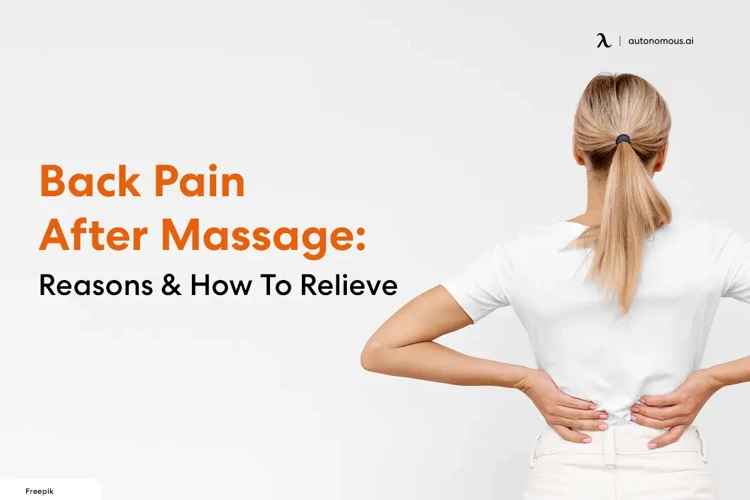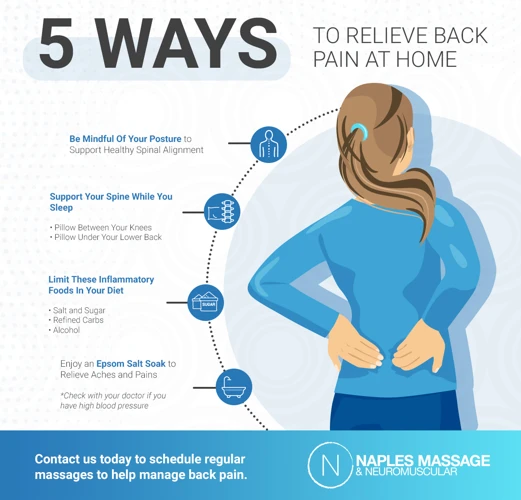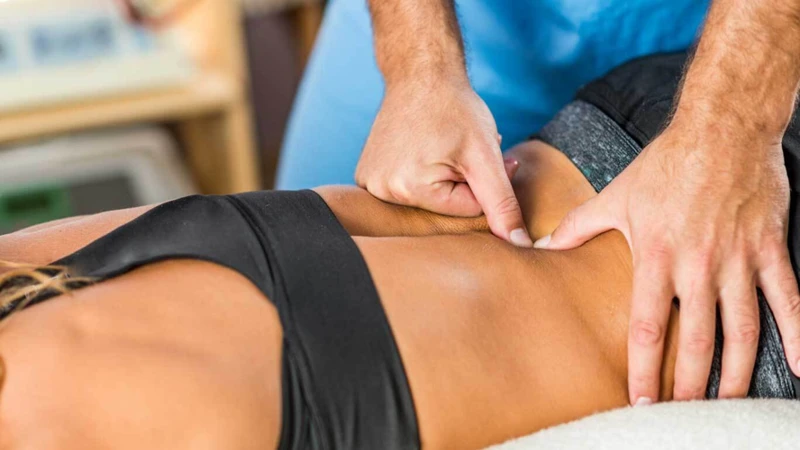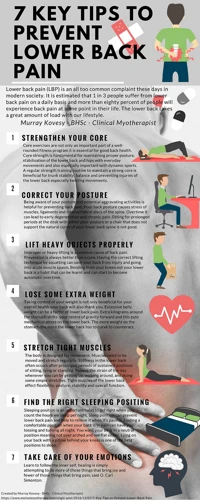Have you ever experienced lower back pain after a massage? If so, you’re probably wondering “why does my lower back hurt after a massage?” While it’s not uncommon to feel sore after a massage, it’s important to understand why your lower back is hurting so that you can take the necessary steps to address the issue. In this article, we’ll uncover the reasons behind lower back pain after a massage, and provide tips to help you alleviate the discomfort.
Contents
Causes of Lower Back Pain after a Massage

Poor Posture
Poor posture can be a contributing factor to lower back pain, even after a massage. Poor posture during a massage can put extra strain on certain muscles, which can cause pain or spasms. It is important to maintain good posture during a massage and to be aware of any discomfort that may arise.
Muscle Tension
Muscle tension can also be a cause for lower back pain after a massage. When muscles are tense, they can become tight and cause pain or spasms. It is important to discuss any areas of tension with the massage therapist so that they can address these areas during the treatment.
Inadequate Pressure
Inadequate pressure can also be a cause for lower back pain after a massage. If the massage therapist is not applying enough pressure during the treatment, it can result in pain afterwards. It is important to communicate with the massage therapist to ensure they are using the correct amount of pressure.
Longer Treatment Sessions
Longer treatment sessions may also lead to lower back pain after a massage. When massage sessions are too long, it can cause the body to become overworked, resulting in pain and spasms. It is important to keep massage sessions to the recommended time to avoid this problem.
When massage makes pain worse, it is important to address the problem with the massage therapist. They can assess the cause of the pain and provide advice on how to avoid it in the future.
Symptoms of Lower Back Pain After a Massage

Lower back pain after a massage can range from mild to severe. Common symptoms include:
- Dull ache – pain that is constant and may be aggravated by movement.
- Burning sensation – the feeling of heat, tingling, or numbness in the lower back.
- Stiffness – difficulty moving or bending due to stiffness in the lower back.
- Tenderness – feeling pain when the lower back is touched.
- Muscle spasms – sudden, involuntary contractions of the lower back muscles.
If you experience any of these symptoms after a massage, it is important to speak to your massage therapist to determine why your lower back is hurting and what can be done to relieve the pain. In some cases, the pain may be due to an underlying condition that requires medical treatment. If this is the case, your massage therapist can refer you to a healthcare provider for further evaluation.
Treatments for Lower Back Pain After a Massage

Heat Therapy
Heat therapy can help relax tight muscles and reduce inflammation. Applying a heating pad or hot water bottle to the affected area for 20 minutes at a time can provide relief.
Massage Therapy
Massage therapy can help reduce muscle tension and increase circulation. A massage therapist can apply specific techniques to the affected area to help reduce pain and stiffness.
Stretching
Gentle stretching can help reduce muscle tension and increase flexibility. Stretches should be done slowly and carefully, and should be stopped if any pain or discomfort is felt.
Exercises
Strengthening exercises can help support the spine and reduce pressure on the affected area. Exercises should be tailored to the individual’s specific needs and should be performed with proper form and technique.
Medications
Over-the-counter medications such as ibuprofen and acetaminophen can help reduce inflammation and relieve pain. Prescription medications may be necessary to manage more severe pain.
Prevention of Lower Back Pain After a Massage

Proper Posture
Maintaining proper posture during a massage session is essential in order to prevent lower back pain. It is important to make sure the massage therapist is aware of any existing lower back pain and to adjust the massage table or massage chair accordingly. It is also important to keep the lower back flat during the massage session, as any arching or curving of the lower back may cause strain and discomfort.
Proper Pressure
Using the correct pressure during a massage is also important in order to prevent lower back pain. If the pressure is too light, it may not provide the desired result, but if the pressure is too heavy, it can cause pain and discomfort. It is important for the massage therapist to use the correct amount of pressure for the individual receiving the massage.
Proper Length of Treatment Sessions
Limiting the length of massage sessions is also important in order to prevent lower back pain. If the massage session is too long, it can cause strain and discomfort. It is important to keep the massage session within a reasonable time frame in order to prevent lower back pain.
Summary
- Lower back pain after a massage is a relatively common symptom, but can be caused by a few different underlying factors.
- The massage itself can cause over-exertion of the muscles, leading to pain and soreness.
- Incorrect postural alignment can also be a factor, leading to pain in the lower back.
- Poorly trained massage therapists can cause discomfort and pain due to incorrect technique.
- Massage oils and lotions can cause skin irritation or allergic reactions, which can lead to lower back pain.
Frequently Asked Questions
What are the Common Causes of Lower Back Pain After a Massage?
Common causes of lower back pain after a massage include overworked muscles, poor posture, pinched nerves, and poor massage technique. Overworked muscles can become inflamed, causing pain and discomfort. Poor posture can cause muscle imbalances, leading to lower back pain. Pinched nerves can be caused by tight muscles, which can be a result of poor posture or massage technique. Poor massage technique can include too much pressure or incorrect use of massage tools, which can cause inflammation, trauma, and pain.
Is Lower Back Pain After a Massage a Sign of Injury?
Yes:
- Lower back pain after a massage can be a sign of an underlying injury.
- It is important to identify the source of the pain before proceeding with any form of treatment.
- Common signs of injury include pain that persists for more than 48 hours, tenderness, swelling, and limited range of motion.
- If any of these signs are present, it is important to seek medical attention.
No:
- Lower back pain after a massage may not always be a sign of injury.
- It is possible that the pain is caused by a buildup of lactic acid or a muscle strain.
- If the pain resolves itself within 48 hours, it is likely not a sign of an underlying injury.
- It is important to monitor the pain and take appropriate steps to reduce the discomfort.
How Can I Prevent Lower Back Pain After a Massage?
To prevent lower back pain after a massage, it is important to ensure the massage therapist is experienced and qualified, and that the massage is tailored to your individual needs. Additionally, ask your massage therapist to avoid deep tissue massage and focus on gentle, soothing strokes instead. To reduce the risk of pain, take breaks during the massage and drink plenty of water afterwards. Before getting a massage, stretch or do light exercises to warm up your body and keep your muscles loose. Finally, apply a cold or warm compress to the affected area after the massage to reduce inflammation and pain.
What should I do if I experience lower back pain after a massage?
Seek medical help: If you experience severe pain in the lower back after a massage, it is recommended to seek medical help as soon as possible.
Rest and ice: Take some rest and apply an ice pack to the area. This will reduce inflammation and help to relieve the pain.
Heat therapy: Applying a heating pad to the affected area can help to relax the muscles and reduce the pain.
Pain relievers: Taking over-the-counter pain relievers such as ibuprofen or acetaminophen can help to reduce the pain.
Massage again: If the pain does not subside after a few days, consider getting another massage. A different technique may be used to provide relief.
Stretching: Gentle stretching can help to reduce the tension in the affected area and relieve the pain.
Good posture: Maintaining good posture while sitting, standing, and sleeping can help to alleviate the pain.
Exercise: Strengthening the core muscles can help to reduce the strain on the lower back. Low-impact exercises such as swimming and walking can also help.
Are there any long-term effects of lower back pain after a massage?
Yes, there are potential long-term effects of lower back pain after a massage.
- It can lead to chronic pain if the massage is too intense or done incorrectly.
- It can cause nerve damage if the massage is too strong or applied in a wrong way.
- It can lead to muscle imbalances with overworked muscles on one side and underworked muscles on the other side.
- It can cause muscle spasms and trigger points in the affected area.
- It can cause inflammation and swelling in the affected area.
- It can cause the development of knots in the muscles.
- It can cause fatigue and exhaustion due to the strain on the body.
- It can increase the risk of developing an injury or aggravating an existing injury.
Therefore, it is important to get professional help when it comes to massage therapy and to make sure that the massage therapist is properly trained and experienced in order to avoid any long-term negative effects.
Conclusion
Lower back pain after a massage can be caused by various factors, including muscle tension, incorrect posture, and physical injuries. It is important to communicate with your massage therapist if you experience any pain or discomfort during or after the massage. Additionally, it is important to maintain a healthy lifestyle and practice good posture to avoid or reduce lower back pain.

